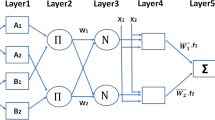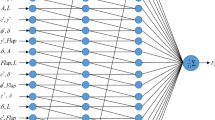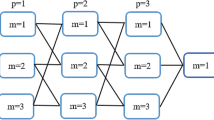Abstract
A new forecast method is proposed in order to improve the estimation accuracy of the ultimate bearing capacity (UBC) of single driven piles. The performance of the adaptive neuro-fuzzy inference system (ANFIS) and multilayer perceptron (MLP) models have been boosted using gray wolf optimization (GWO). To train the models, data were used from 100 driven piles in c-φ soil in different locations. The input parameters were pile area (m2), pile length (m), flap number, average cohesion (kN/m2) and friction angle (°), average soil specific weight (kN/m2) and average pile–soil friction angle (°), and the output was UBC. The results showed that both the MLP and ANFIS methods had good abilities to predict the UBC of the piles; however, the MLP-GWO model with a topology of 7 × 10 × 10 × 1 provided better results. The performance indices of this model were a RMSE of 1.86 kN and R2 of 0.991 for the test data. The validity of the MLP-GWO model was tested using a new experimental dataset, and the difference between actual and estimated UBC was very low (about 2%) and confirmed the high accuracy of the model. It was observed that the theoretical methods underestimated the UBC significantly, while the proposed model estimated the UBC with high accuracy. Sensitivity analysis confirmed that the pile area and length were the most effective factors for estimation of UBC.












Similar content being viewed by others
References
Ahmad I, El Naggar MH, Khan AN (2007) Artificial neural network application to estimate kinematic soil pile interaction response parameters. Soil Dyn Earthq Eng 27(9):892–905
Akay B, Karaboga D (2011) Wavelet packets optimization using artificial bee colony algorithm. In: 2011 IEEE Congress on evolutionary computation (CEC), IEEE, 89–94
Alkroosh I, Nikraz H (2014) Predicting pile dynamic capacity via application of an evolutionary algorithm. Soils Found 54(2):233–242
Alkroosh IS, Bahadori M, Nikraz H, Bahadori A (2015) Regressive approach for predicting bearing capacity of bored piles from cone penetration test data. J Rock Mech Geotech 7(5):584–592
Ardakani A, Kordnaeij A (2019) Soil compaction parameters prediction using GMDH-type neural network and genetic algorithm. Eur J Environ Civ En 23(4):449–462
Ardalan H, Eslami A, Nariman-Zadeh N (2009) Piles shaft capacity from CPT and CPTu data by polynomial neural networks and genetic algorithms. Comput Geotech 36(4):616–625
Babanouri N, Fattahi H (2020) An ANFIS–TLBO criterion for shear failure of rock joints. Soft Comput 24(7):4759–4773
Bagheri A, Zadeh NN, Haraj M, Moghaddam RY (2005) Identification of the dynamical parameters of a 2-Rrobot using ANFIS. In: IEEE, ICMA 2005, 505–509
Das BM (2015) Principles of foundation engineering. Cengage Learn
Das SK, Suman S (2015) Prediction of lateral load capacity of pile in clay using multivariate adaptive regression spline and functional network. Arab J Sci Eng 40(6):1565–1578
Dehghanbanadaki A, Sotoudeh MA, Golpazir I, Keshtkarbanaeemoghadam A, Ilbeigi M (2019) Prediction of geotechnical properties of treated fibrous peat by artificial neural networks. B Eng Geol Environ 78(3):1345–1358
Dehghani M, Riahi-Madvar H, Hooshyaripor F, Mosavi A, Shamshirband S, Zavadskas EK, Chau KW (2019) Prediction of hydropower generation using grey wolf optimization adaptive neuro-fuzzy inference system. Energies 12(2):289
Ebrahimian B, Movahed V (2017) Application of an evolutionary based approach in evaluating pile bearing capacity using CPT results. Ships Offshore Struct 12(7):937–953
Ewees A, Elaziz MA (2018) Improved adaptive neuro-fuzzy inference system using gray wolf optimization: a case study in predicting biochar yield. J Intell Syst 29(1):924–940
Fellenius BH (1989) Predicted and observed axial behavior of piles. Proc., Symp. on Driven Pile Bearing Capacity Prediction, ASCE, New York, 75–115
Fellenius BH, Altaee A (2002) Pile dynamics in geotechnical practice - six case histories. Proc., Int. Deep Foundation Cong., Down to Earth Technology, ASCE, Orlando, Florida, 619–633
Garson GD (1991) Interpreting neural-network connection weights. Artif Intell Expert 6(7):47–55
Goh ATC (1996) Pile driving records reanalyzed using neural networks. J Geotech Eng 22(6):492–495
Harandizadeh H, Toufigh MM, Toufigh V (2018) Application of improved ANFIS approaches to estimate bearing capacity of piles. Soft Comput, pp 1–13
Harandizadeh H, Armaghani DJ, Khari M (2019) A new development of ANFIS–GMDH optimized by PSO to predict pile bearing capacity based on experimental datasets. Eng Comput, pp 1–16
Ismail A, Jeng DS (2011) Modelling load-settlement behaviour of piles using high-order neural network (HON-PILE model). Eng Appl Artif Intell 24(5):813–821
Jaafari A, Panahi M, Pham BT, Shahabi H, Bui DT, Rezaie F, Lee S (2019) Meta optimization of an adaptive neuro-fuzzy inference system with grey wolf optimizer and biogeography-based optimization algorithms for spatial prediction of landslide susceptibility. CATENA 175:430–445
JANBU N (ed.) (1976) Static bearing capacity of friction piles. In: Proceedings of the 6th European conference on soil mechanics and foundation engineering, vol 1.2, 479–488
Jang JSANFIS (1993) Adaptive-network-based fuzzy inference system. IEEE Trans Syst Man Cybern 23(3):665–685
Jebur AA, Atherton W, Al Khaddar RM, Loffill E (2018) Artificial neural network (ANN) approach for modelling of pile settlement of open-ended steel piles subjected to compression load. Eur J Environ Civ En, 1–23
Jokar MH, Khosravi A, Heidaripanah A, Soltani F (2019) Unsaturated soils permeability estimation by adaptive neuro-fuzzy inference system. Soft Comput 23(16):6871–6881
Józefiak K, Zbiciak A, Ma´slakowski M, Piotrowski T (2015) Numerical modelling and bearing capacity analysis of pile foundation. Procedia Eng 111:356–363
Kamgar R, Bagherinejad MH, Heidarzadeh H (2020) A new formulation for prediction of the shear capacity of FRP in strengthened reinforced concrete beams. Soft Comput 24(9):6871–6887
Karaboga D, Kaya E (2014) Training ANFIS using artificial bee colony algorithm for nonlinear dynamic systems identification. In: Proceedings of 2014 22nd signal processing and communications applications conference, SIU 2014, pp 493–496
Karaboga D, Kaya E (2017) Training ANFIS by using the artificial bee colony algorithm. Turk J Electr Eng Comput Sci 25(3):1669–1679
Karaboga D, Training, Kaya E (2013) ANFIS using artificial bee colony algorithm. In: 2013 IEEE international symposium on innovations in intelligent systems and applications. IEEE INISTA 2013 https://doi.org/10.1109/INISTA.2013.6577625
Keshtkarbanaeemoghadam A, Dehghanbanadaki A, Kaboli MH (2018) Estimation and optimization of heating energy demand of a mountain shelter by soft computing techniques. Sustain Cities Soc 41:728–748
Khari M, Dehghanbanadaki A, Motamedi S, Armaghani DJ (2019a) Computational estimation of lateral pile displacement in layered sand using experimental data. Measurement
Khari M, Armaghani, DJ, Dehghanbanadaki A (2019b) Prediction of lateral deflection of small-scale piles using hybrid PSO–ANN model. Arab J Sci Eng, pp 1–11
Kim B, Kim T, Lee SH (2001) Prediction of lateral behavior of single and group piles using artificial neural networks. Ksce J Civ Eng 5(2):185–198
Kohli M, Arora S (2018) Chaotic grey wolf optimization algorithm for constrained optimization problems. J Comput Des Eng 5(4):458–472
Konstantinov SV, Khamidova UK, Sofronova EA (2019) A novel hybrid method of global optimization based on the grey wolf optimizer and the bees algorithm. Procedia Comput Sci 150:471–477
Larry M (1988) Analysis of the pile load test at the lock and dam 26 replacement project, Research Report 4690F. Texas A&M University, Texas, pp 15–33
Liang BL, Gao Y, Zhu L, Lv GB, Li X (2005) Prediction of pile displacement using PSO algorithm and artificial neural networks. China Univ Geosciences Press, Wuhan
Lutfy O, Noor SB, Marhaban MH, Abbas KA (2010) A Simplified PID-like ANFIS controller trained by genetic algorithm to control nonlinear systems. Aust J Basic Appl Sci 4:6331–6345
Mahapatra S, Daniel R, Dey DN, Nayak SK (2015) Induction motor control using PSO-ANFIS. Proc Comput Sci 48:753–768
Maizir H (2017) Evaluation of shaft bearing capacity of single driven pile using neural network. In: Proceedings of the international multi conference of engineers and computer scientists, IMECS, March 15–17, Hong Kong
Marzbanrad J, Jamali A (2009) Design of ANFIS networks using hybrid genetic and SVD methods for modeling and prediction of rubber engine mount stiffness. Int J Autom Technol 10:167–174
Matlab. The language of technical learning. Matworks Version R2018a
Mehrdad A, Nariman-Zadeh N, Jamali A, Teymoorzadeh A (2005) ANFIS networks design using hybrid genetic and SVD methods for modelling of the level variations of the Caspian Sea. WSEAS Trans Inf Sci Appl 2:121–126
Milad F, Kamal T, Nader H, Erman OE (2015) New method for predicting the ultimate bearing capacity of driven piles by using Flap number. Ksce J Civ Eng 19(3):611–620
Mirjalili S, Mirjalili SM, Lewis A (2014) Grey wolf optimizer. Adv Eng Softw 69:46–61
Moayedi H, Armaghani DJ (2017) Optimizing an ANN model with ICA for estimating bearing capacity of driven pile in cohesionless soil. Eng Comput 34:1–10
Moayedi H, Hayati M (2018) Artificial intelligence design charts for predicting friction capacity of driven pile in clay. Neural Comput Appl, pp 1–17
Moayedi H, Raftari M, Sharifi A, Jusoh WAW, Rashid ASA (2020) Optimization of ANFIS with GA and PSO estimating α ratio in driven piles. Eng Comput 36(1):227–238
Mohanty R, Suman S, Das SK (2018) Prediction of vertical pile capacity of driven pile in cohesion less soil using artificial intelligence techniques. Int J Geotech Eng 12(2):209–216
Momeni E, Nazir R, Armaghani DJ, Maizir H (2015a) Application of artificial neural network for predicting shaft and tip resistances of concrete piles. Earth Sci Res J 19(1):85–93
Momeni E, Armaghani D, Hajihassani M, Amin M (2015b) Prediction of uniaxial compressive strength of rock samples using hybrid particle swarm optimization-based artificial neural networks. Measurement 60:50–63
Momeni E, Dowlatshahi MB, Omidinasab F, Maizir H, Armaghani DJ (2020) Gaussian process regression technique to estimate the pile bearing capacity. Arab J Sci Eng, pp 1–13
Nariman-Zadeh N, Darvizeh A, Dadfarmai MH (2003) Adaptive neurofuzzy inference systems networks design using hybrid genetic and singular value decomposition methods for modeling and prediction of the explosive cutting process. Artif Intell Eng Des Anal Manuf AIEDAM 17:313–324
Nejad FP, Jaksa MB (2017) Load-settlement behavior modeling of single piles using artificial neural networks and CPT data. Comput Geotech 89:9–21
Nhu HN, Nitsuwat S, Sodanil M (2013) Prediction of stock price using an adaptive Neuro-fuzzy inference system trained by firefly algorithm. In: 2013 international computer science and engineering conference 2013, pp 302–307
Niu M, Wang Y, Sun S, Li Y (2016) A novel hybrid decomposition-and-ensemble model based on CEEMD and GWO for short-term PM2.5 concentration forecasting. Atmos Environ 134:168–180
Okdem S, Karaboga D, Ozturk C (2011) An application of wireless sensor network routing based on artificial bee colony algorithm. In: 2011 IEEE Congress on evolutionary computation (CEC). IEEE, pp 326–330
Oliveira MV, Schirru R (2009) Applying particle swarm optimization algorithm for tuning a neuro-fuzzy inference system for sensor monitoring. Prog Nucl Energy 51:177–181
Park HI, Cho CW (2010) Neural network model for predicting the resistance of driven piles. Mar Georesour Geotechnol 28(4):324–344
Sadrossadat E, Heidaripanah A, Osouli S (2016) Prediction of the resilient modulus of flexible pavement subgrade soils using adaptive neuro-fuzzy inference systems. Constr Build Mater 123:235–247
Sadrossadat E, Ghorbani B, Oskooei R, Kaboutari M (2018) Use of adaptive neuro-fuzzy inference system and gene expression programming methods for estimation of the bearing capacity of rock foundations. Eng Comput 35(5):2078–2106
Salmalian K, Soleimani M (2011) Modelling of energy absorption in square cross-section aluminum energy absorbers by hybrid ANFIS networks. Int J Math Models Methods Appl Sci 5:1154–1161
Sari PA, Suhatril M, Osman N, Mu’azu MA, Katebi J, Abavisani A, Petkovic D (2019) Developing a hybrid adoptive neuro-fuzzy inference system in predicting safety of factors of slopes subjected to surface eco-protection techniques. Eng Comput, pp 1–8
Shahin MA, Jaksa MB, Maier HR (2001) Artificial neural network application in geotechnical engineering. Aust Geomech, pp 49–62
Shankar K, Lakshmanaprabu SK, Khanna A, Tanwar S, Rodrigues JJ, Roy NR (2019) Alzheimer detection using Group Grey Wolf Optimization based features with convolutional classifier. Comput Electr Eng 77:230–243
Sharma A, Vijay R, Bodhe GL, Malik LG (2018) An adaptive neuro-fuzzy interface system model for traffic classification and noise prediction. Soft Comput 22(6):1891–1902
Sheniha SF, Priyadharsini SS, Rajan SE (2013) Removal of artifact from EEG signal using differential evolution algorithm. In: Proceedings of the international conference on communication and signal processing, ICCSP, pp 134–138
Shoorehdeli MA, Teshnehlab M, Sedigh AK (2006) A novel training algorithm in ANFIS structure. In: Proceedings of the American control conference, pp 5059–5064
Sihag P, Esmaeilbeiki F, Singh B, Ebtehaj I, Bonakdari H (2019) Modeling unsaturated hydraulic conductivity by hybrid soft computing techniques. Soft Comput 23(23):12897–12910
Stockard DM (1979) Case histories-pile driving in the Gulf of Mexico. In: Proceedings of the 11th Annual OTC, Houston, Texas, pp 737–747
Stockard DM (1986) Case histories-pile driving offshore India. In: Proceedings of the 18th Annual OTC, Houston, Texas, pp 56–68
Sugeno M, Kang GT (1988) Structure identification of fuzzy model. Fuzzy Sets Syst 28(1):15–33
Suman S, Das SK, Mohanty R (2016) Prediction of friction capacity of driven piles in clay using artificial intelligence techniques. Int J Geotech Eng 10(5):469–475
Tarawneh B, Imam R (2014) Regression versus artificial neural networks: predicting pile setup from empirical data. KSCE J Civ Eng 18(4):1018–1027
Teshnehlab M, Shoorehdeli MA, Sedigh AK (2008) Novel hybrid learning algorithms for tuning ANFIS parameters as an identifier using fuzzy PSO. In: Proceedings of 2008 IEEE international conference on networking, sensing and control, ICNSC, pp 111–116
Thomas S, Pillai GN, Pal K, Jagtap P (2016) Prediction of ground motion parameters using randomized ANFIS (RANFIS). Appl Soft Comput 40:624–634
Toha SF, Tokhi MO (2010) ANFIS modelling of a twin rotor system using particle swarm optimization and RLS. In: 2010 IEEE 9th international conference on cybernetic intelligent systems, CIS 2010
Tsai JT, Chiu KY, Chou JH (2015) Optimal design of SAW gas sensing device by using improved adaptive neuro-fuzzy inference system. IEEE Access 3:420–429
Wang JS (2007) Parameters optimization of ANFIS based on particle swarm optimization (Shiyou Huagong Gaodeng Xuexiao Xuebao). J Pet Univ 20:41–44
Xia TA, Wang W, Wang XN (2010) Artificial neural network model for time-dependent vertical bearing capacity of preformed concrete pile. In: Tan HH (ed) Applied mechanics and mechanical engineering, pts 1–3. Trans Tech Publications Ltd, Stafa-Zurich, pp 226–230
Xie Y, Liu C, Gao S, Tang J, Chen Y (2017) Lateral load bearing capacity of offshore high-piled wharf with batter piles. Ocean Eng 142:377–387
Zhang W, Goh ATC (2016) Multivariate adaptive regression splines and neural network models for prediction of pile drivability. Geosci Front 7(1):45–52
Zhang W, Zh J, Kong LF (2011) Gradient genetic algorithm-based performance fault diagnosis model. In: AIMSEC 2011—Proceedings 2011 2nd international conference on artificial intelligence, management science and electronic commerce, pp 3059–3062
Ziaee SA, Sadrossadat E, Alavi AH, Shadmehri DM (2015) Explicit formulation of bearing capacity of shallow foundations on rock masses using artificial neural networks: application and supplementary studies. Environ Earth Sci 73(7):3417–3431
Author information
Authors and Affiliations
Corresponding author
Ethics declarations
Conflict of interest
The author declares that there is no conflict of interest in presenting this manuscript.
Additional information
Communicated by V. Loia.
Publisher's Note
Springer Nature remains neutral with regard to jurisdictional claims in published maps and institutional affiliations.
Rights and permissions
About this article
Cite this article
Dehghanbanadaki, A., Khari, M., Amiri, S.T. et al. Estimation of ultimate bearing capacity of driven piles in c-φ soil using MLP-GWO and ANFIS-GWO models: a comparative study. Soft Comput 25, 4103–4119 (2021). https://doi.org/10.1007/s00500-020-05435-0
Published:
Issue Date:
DOI: https://doi.org/10.1007/s00500-020-05435-0




